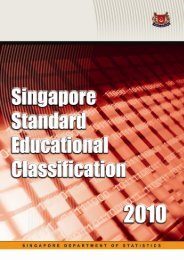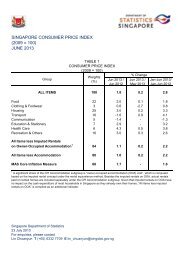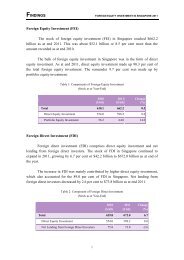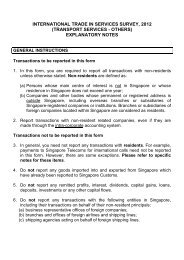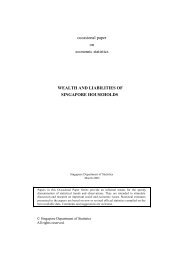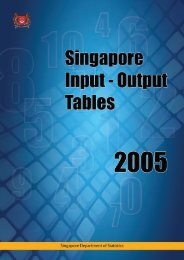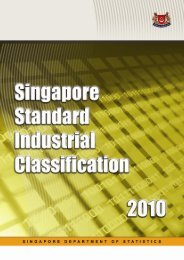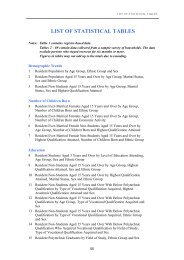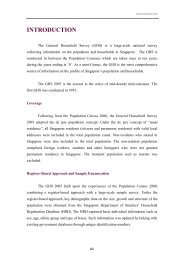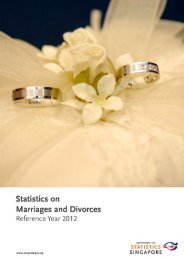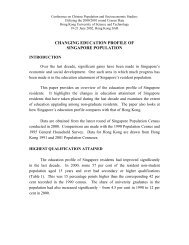Glossary - Statistics Singapore
Glossary - Statistics Singapore
Glossary - Statistics Singapore
You also want an ePaper? Increase the reach of your titles
YUMPU automatically turns print PDFs into web optimized ePapers that Google loves.
GLOSSARY OF TERMS AND DEFINITIONS<br />
DEMOGRAPHIC AND SOCIAL CHARACTERISTICS<br />
Age<br />
Age refers to the number of completed years between a person‟s date of birth and the<br />
reference date of 30 June 2010.<br />
Ethnic/ Dialect Group<br />
Ethnic group refers to a person‟s race. It is as declared by the person. The population<br />
is classified into the following four categories:<br />
Chinese<br />
Malays<br />
Indians<br />
Other Ethnic Groups<br />
This refers to persons of Chinese origin such as Hokkiens, Teochews,<br />
Cantonese, Hakkas, Hainanese, Hockchias, Foochows, Henghuas,<br />
Shanghainese, etc.<br />
This refers to persons of Malay or Indonesian origin, such as<br />
Javanese, Boyanese, Bugis, etc.<br />
This refers to persons of Indian, Pakistani, Bangladeshi or Sri Lankan<br />
origin such as Tamils, Malayalis, Punjabis, Bengalis, Singhalese, etc.<br />
This comprises all persons other than Chinese, Malays and Indians.<br />
They include Eurasians, Europeans, Arabs, Japanese, etc.<br />
Residential Status<br />
<strong>Singapore</strong> citizens and permanent residents are classified as <strong>Singapore</strong> residents or the<br />
resident population. <strong>Singapore</strong> permanent residents refer to non-citizens who have<br />
been granted permanent residence in <strong>Singapore</strong>. The non-resident population<br />
comprised foreigners who were working, studying or living in <strong>Singapore</strong> but not<br />
granted permanent residence, excluding tourists and short-term visitors.<br />
Place of Birth<br />
Place of birth refers to the geographical area in which the person was born.<br />
Marital Status<br />
Marital status refers to a person‟s conjugal status in relation to the marriage laws or<br />
customs in <strong>Singapore</strong>.<br />
181
Single<br />
Married<br />
Widowed<br />
Divorced/ Separated<br />
This refers to persons who have never been married.<br />
This refers to persons who are legally married or married according<br />
to customary rites.<br />
This refers to persons whose spouses are deceased and have not<br />
remarried.<br />
This refers to persons whose marriages have been legally dissolved,<br />
or persons who have been legally separated or estranged from their<br />
spouses and who have not remarried.<br />
Ever-Married Females<br />
Ever-married females refer to females who have been married before and are currently<br />
married, widowed, or divorced/ separated.<br />
Number of Children Born<br />
Number of children born refers to all the live-born children each resident woman aged<br />
15 years and over has ever given birth to. It includes those children who are currently<br />
staying with her, those who have set up their own homes and those who are no longer<br />
living.<br />
Religion<br />
Religion refers to the religious faith or spiritual belief of a person, regardless of<br />
whether or not he regularly attends religious ceremonies in a temple, mosque, church<br />
or other religious building. He may or may not practise his faith or belief. It is as<br />
declared by the person.<br />
182
EDUCATION, LITERACY AND LANGUAGE<br />
Literacy<br />
This refers to a person‟s ability to read with understanding, e.g. a newspaper, in the<br />
language(s) specified. It is as declared by the person.<br />
Language Most Frequently Spoken at Home<br />
Language most frequently spoken at home refers to the language or dialect that a<br />
person uses most frequently at home when speaking to household members.<br />
Level of Education Attending<br />
Level of education attending refers to the grade or standard of formal education which<br />
a full-time student is attending. The <strong>Singapore</strong> Standard Educational Classification<br />
2010 is used to classify students by level of education attending. Students aged 5 years<br />
and over are classified into the following six main categories:<br />
Pre-Primary<br />
Primary<br />
Secondary<br />
Post-Secondary<br />
(Non-Tertiary)<br />
Polytechnic<br />
Professional Qualification and<br />
Other Diploma<br />
University<br />
This refers to students attending kindergartens or pre-primary<br />
classes.<br />
This refers to students attending Primary 1 to 6 and special classes<br />
for the educationally sub-normal.<br />
This refers to students attending Secondary 1 to 5 or courses of<br />
secondary level offered in the vocational, technical and commercial<br />
education institutions, e.g. Institute of Technical Education (ITE)<br />
Skills Certificate course.<br />
This refers to students attending Pre-University classes and junior<br />
colleges or other courses at post-secondary level, e.g. National ITE<br />
Certificate (Nitec), Higher Nitec and Master Nitec.<br />
This refers to students attending polytechnic diploma or polytechnic<br />
post/ advanced/ specialist/ management/ graduate diploma courses<br />
offered by the local polytechnics such as the <strong>Singapore</strong><br />
Polytechnic, Ngee Ann Polytechnic, Temasek Polytechnic,<br />
Nanyang Polytechnic and Republic Polytechnic.<br />
This refers to students attending courses leading to the award of<br />
professional qualification and other diploma, e.g. ITE diploma,<br />
National Institute of Education (NIE) diploma, <strong>Singapore</strong> Institute<br />
of Management (SIM) diploma, LASALLE diploma, Nanyang<br />
Academy of Fine Arts (NAFA) diploma, Association of Chartered<br />
Certified Accountants (ACCA) Qualification and Chartered<br />
Financial Analyst (CFA).<br />
This refers to students attending degree or postgraduate courses in<br />
universities.<br />
183
Highest Qualification Attained<br />
Highest qualification attained refers to the highest grade or standard a person has<br />
passed or the highest level where a certificate, diploma, or degree is awarded. The<br />
<strong>Singapore</strong> Standard Educational Classification 2010 is used to classify persons by<br />
highest qualification attained. Persons aged 15 years and over who are not attending<br />
educational institutions as full-time students are classified into the following main<br />
categories:<br />
No Qualification<br />
Primary<br />
Lower Secondary<br />
Secondary<br />
Post-Secondary<br />
(Non-Tertiary)<br />
Polytechnic<br />
This refers to those who have never attended school, or have<br />
primary education but without Primary School Leaving<br />
Examination (PSLE) certificate or equivalent, or have Certificate in<br />
Basic Education for Skills Training (BEST) 1-3.<br />
This refers to those who have PSLE or other certificates of<br />
equivalent standard, or have Certificate in BEST 4 or at least 3<br />
Employability Skills Systems (ESS) Workplace Literacy and<br />
Numeracy (WPLN) Statements of Attainment at Level 1 or 2.<br />
This refers to those who have secondary education without a<br />
General Certificate of Education (GCE) Normal („N‟)/ Ordinary<br />
(„O‟) Level pass or equivalent, or have Certificate in Worker<br />
Improvement through Secondary Education (WISE) 1-3, or basic<br />
vocational certificates (including ITE Basic Vocational Training),<br />
or at least 3 ESS WPLN Statements of Attainment at Level 3 or 4.<br />
This refers to those who have at least 1 GCE „N‟/ „O‟ Level pass, or<br />
have National ITE Certificate (Intermediate) or equivalent (e.g.<br />
National Technical Certificate Grade 3, Certificate of Vocational<br />
Training), or have ITE Skills Certificate (ISC) or equivalent (e.g.<br />
Certificate of Competency, Certificate in Service Skills) or at least<br />
3 ESS WPLN Statements of Attainment at Level 5 and above.<br />
This refers to those who have at least 1 GCE Advanced („A‟)/<br />
Higher 2 („H2‟) Level pass or other certificates/ qualifications of<br />
equivalent standard. It also includes those who have Nitec (e.g.<br />
Post Nitec Certificate, Certificate in Office Skills, National<br />
Technical Certificate Grade 2, National Certificate in Nursing,<br />
Advanced Builder Certificate), or have Higher Nitec (including<br />
Certificate in Business Skills, Industrial Technician Certificate and<br />
other polytechnic certificates), or Master Nitec or equivalent (e.g.<br />
National Technical Certificate Grade 1). This group also includes<br />
Workforce Skills Qualifications (WSQ) Certificate/ Higher<br />
Certificate/ Advanced Certificate or equivalent, International<br />
Baccalaureate/ High School diploma or other advanced certificates<br />
(e.g. SIM certificates).<br />
This refers to those who have polytechnic diploma, or polytechnic<br />
advanced diploma (including polytechnic advanced/ post/<br />
specialist/ management/ graduate diploma), or polytechnic postdiploma<br />
certificate.<br />
184
Professional Qualification and<br />
Other Diploma<br />
University<br />
This refers to those who have qualifications awarded by<br />
professional bodies, or NIE diploma, ITE diploma and other<br />
diploma qualifications (e.g. SIM diploma, LASALLE diploma,<br />
NAFA diploma, WSQ diploma and WSQ specialist diploma).<br />
This refers to those who have bachelor‟s degree, or postgraduate<br />
diploma (including NIE postgraduate diploma), or master‟s degree,<br />
or doctorate. It also includes persons with WSQ graduate certificate<br />
and WSQ graduate diploma.<br />
Field of Study<br />
Field of study refers to the principal discipline, branch or subject matter of study that<br />
leads to the award of the qualification attained. The <strong>Singapore</strong> Standard Educational<br />
Classification 2010 is used to classify the subject matter of study.<br />
ECONOMIC CHARACTERISTICS<br />
Economic Status<br />
The economic status of a person refers to whether a person was working during the<br />
seven days preceding the day he was enumerated. Persons aged 15 years and over are<br />
classified as either economically active or economically inactive.<br />
Economically active persons refer to persons who were working and those who were<br />
actively looking for work if not working during the reference period.<br />
Working<br />
Unemployed<br />
A working person is one who during the reference period, worked<br />
for pay or profit. It includes those serving National Service, as well<br />
as those who were helping in a family business without fixed pay. It<br />
also includes all those who had a job or business to return to but<br />
were temporarily absent because of illness, injury or other reasons.<br />
An unemployed person is one who was not working during the<br />
reference period but was actively looking for work or planning to<br />
start his own business.<br />
Economically inactive persons refer to persons who were not working and not actively<br />
looking for work during the reference period.<br />
Occupation<br />
Occupation of a working person refers to the kind of work that the person was doing<br />
during the reference period. The <strong>Singapore</strong> Standard Occupational Classification 2010<br />
is used to classify working persons by occupation.<br />
185
Industry<br />
Industry refers to the kind of economic activity or the nature of business of the firm,<br />
establishment or department in which the person was employed during the reference<br />
period. If the person was self-employed, industry refers to the kind of economic<br />
activity or nature of business the person was operating. The <strong>Singapore</strong> Standard<br />
Industrial Classification 2010 is used to classify all working persons by industry.<br />
Employment Status<br />
Employment status refers to the status of working persons in relation to their<br />
employment. Working persons aged 15 years and over are classified into the<br />
following categories:<br />
Employers<br />
Own Account Workers<br />
Employees<br />
Contributing Family Workers<br />
These are persons who employ at least one paid worker in their<br />
business or trade.<br />
These are persons who operate their own business without<br />
employing any paid workers in the conduct of their business or<br />
trade.<br />
These are persons who work for employers in return for regular<br />
wages or salaries.<br />
These are persons who assist in the operation of family business<br />
without receiving regular wages or salaries.<br />
Usual Hours Worked<br />
This refers to the number of hours that a person usually works in a typical week,<br />
regardless of whether he is paid or not. The concept of usual hours of work differs<br />
from that of normal hours of work referred to in contractual arrangements. For a<br />
person who has just started work during the reference period, usual hours of work<br />
refers to the number of hours per week he is expected to work in that job. For a<br />
multiple jobholder, it should be aggregated from the hours spent in all the jobs.<br />
Gross Monthly Income from Work<br />
This refers to the total amount of income earned from employment during the full<br />
calendar month preceding the date of the interview. For employees, this would include<br />
wages or salaries, allowances, overtime, commission, tips and bonuses. It would also<br />
include the employee‟s Central Provident Fund contribution but not the employer‟s<br />
contribution for the employee. For employers and own account workers, it refers to<br />
the total receipts from sales and services performed less the business expenses<br />
incurred.<br />
186
HOUSEHOLD AND HOUSING CHARACTERISTICS<br />
Household<br />
A household refers to a group of two or more persons living together in the same<br />
house and sharing common food or other arrangements for essential living. It also<br />
includes a person living alone or a person living with others but having his own food<br />
arrangements. Although persons may be living in the same house, they may not be<br />
members of the same household.<br />
Resident Household<br />
A resident household refers to a household headed by a <strong>Singapore</strong> citizen or<br />
permanent resident.<br />
Head of Household<br />
The head of a household is the person generally acknowledged as such by other<br />
members of the household. The head is normally the oldest member, the main income<br />
earner, the owner-occupier of the house or the person who manages the affairs of the<br />
household. Where the household comprises a group of unrelated persons, the head of<br />
household refers to the person who manages the affairs of the household, or any<br />
person who supplied the information pertaining to other members.<br />
Household Structure<br />
Household structure refers to the classification of a household according to the<br />
number of family nuclei and the number of generations in the household.<br />
One Family Nucleus<br />
This refers to a household formed by one of the following,<br />
regardless of the number of generations:<br />
(a) a married couple, with or without never-married child(ren);<br />
(b) a family consisting of immediate related members, without<br />
presence of a married couple e.g. one parent only with nevermarried<br />
child(ren).<br />
Two Family Nuclei<br />
Three or More Family Nuclei<br />
No Family Nucleus<br />
This refers to a household with two family nuclei.<br />
This refers to a household with three or more family nuclei.<br />
This refers to a household formed by a person living alone or living<br />
with others but does not constitute any family nucleus. This is<br />
further classified into one-person household or household with<br />
more than one person.<br />
187
Household Living Arrangement<br />
Household living arrangement refers to the classification of a household according to<br />
the household composition, age and marital status of household head and age group of<br />
the youngest child of the head. There are two broad types of households:<br />
Family-Based Households<br />
Non-Family-Based<br />
Households<br />
This refers to households with at least one family nucleus.<br />
This refers to households with no family nucleus.<br />
Within the family-based households, couple-based households refer to those with a<br />
married head and spouse in the household. Other family-based households refer to<br />
those without a married head and spouse in the household, e.g. lone parent households.<br />
Household Size<br />
Household size refers to the total number of members in the household, including<br />
maids.<br />
Number of Working Persons in Household<br />
The number of working persons in the household includes members of the same<br />
household who are working. Maids in the household are excluded.<br />
Household Income from Work<br />
Household income from work refers to the sum of income received by working<br />
members of the household from employment and business. However, it does not<br />
include the income of maids.<br />
Household Income from Work Per Household Member<br />
Household income from work per household member refers to the household income<br />
from work divided by the total number of members (household size) in the household.<br />
For example, if only one person in a household of four is working, his income is<br />
divided by four to derive the average income per household member.<br />
Predominant Household Language<br />
Predominant household language refers to the language or dialect spoken by the<br />
majority of household members to other members, excluding maids and unrelated<br />
persons.<br />
188
Elderly Living Arrangement<br />
Elderly persons aged 65 years and over are classified according to their co-residence<br />
with their spouse or children. Additional dimension on the economic status of the<br />
children is incorporated into the classification.<br />
With At Least One Working<br />
Child<br />
With All Non-Working<br />
Children<br />
This refers to an elderly person living with his children in the same<br />
household, at least one of whom is working.<br />
This refers to an elderly person living with his children in the same<br />
household, all of whom are not working.<br />
Elderly persons who are not living with their spouse or children are classified<br />
according to whether they are living alone or with other elderly persons. Elderly<br />
persons living alone refer to those in one-person households, with or without other<br />
occupants in the same dwelling unit.<br />
Type of Dwelling<br />
A dwelling refers to a building, part of a building, or a covered space used or intended<br />
to be used by one or more persons as living quarters. Each dwelling has its own<br />
separate entrance with direct access to a public road or pathway. A dwelling may be a<br />
residential building by itself, or a unit in a residential building, or part of a nonresidential<br />
building such as a shop or factory with space used as living quarters.<br />
Dwellings are broadly classified into the following three categories: Housing and<br />
Development Board (HDB) flats, condominiums and private flats, and landed<br />
properties.<br />
Tenancy<br />
Tenancy refers to the tenure status of the household with respect to the dwelling in<br />
which the household members live. Tenancy is classified into the following three<br />
categories:<br />
Owner<br />
Tenant<br />
Others<br />
This refers to a household where the head or any other member<br />
owns the house.<br />
This refers to a household which rents the dwelling or part of it.<br />
This refers to a household which occupies a dwelling provided<br />
without charge by employers, friends or relatives.<br />
189
GEOGRAPHIC DISTRIBUTION AND TRANSPORT<br />
Planning Areas<br />
Planning areas refer to areas demarcated in the Urban Redevelopment Authority‟s<br />
Master Plan 2008.<br />
Usual Mode of Transport to School or Work<br />
Usual mode of transport to school or work refers to how a full-time student or a<br />
working person usually travels to school or work respectively. Persons who usually<br />
walk to school or work and persons who study from home or work at their place of<br />
residence are classified in the category “No transport required”.<br />
Travel Time to School or Work<br />
Travel time to school or work refers to the total number of minutes that it usually<br />
takes a full-time student or working person to get from home to school or to work<br />
each day respectively. The travel time includes time spent waiting for public<br />
transportation and walking to the bus-stop or MRT station.<br />
190



